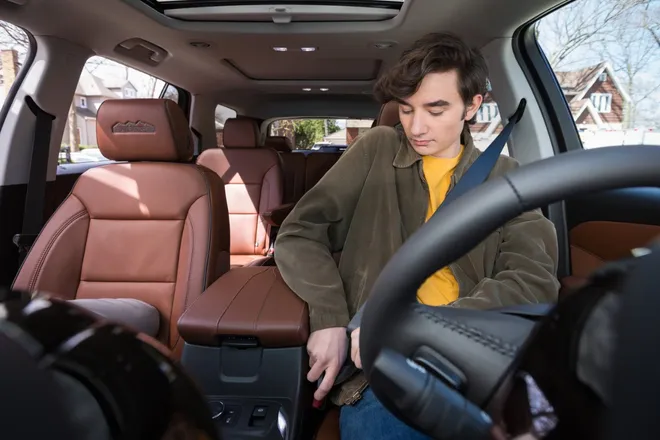How much does it cost to raise a child? College may no longer be the biggest expense.
Parents spend a lot of time worrying about how they’ll afford college tuition for their kids someday, but a pair of recent surveys show exorbitant college-like costs actually come much earlier in life.
In more than half the states, childcare costs more than in-state public college tuition, according to lending platform NetCredit.com. Then, comes the price you pay for independent kids. Teen car ownership now also costs more than in-state tuition at a public university, an analysis by car app Jerry shows.
Everyone already knows raising a child is expensive, but it’s getting even pricier. After two years of elevated inflation, families are feeling pinched more than ever. Overall, for example, parents spend a significant portion of their annual income on child-related expenses. Nationwide, families spend 19% of their annual income on child-rearing expenses, online lending marketplace LendingTree said.
“Ideally, you’d be able to keep childcare costs to 10% or less of your total income,” said Matt Schulz, LendingTree chief credit analyst. “But that’s laughably unrealistic for millions of Americans.”
How expensive is childcare?
On average, childcare costs $1,031 a year more than public college tuition, NetCredit said.
Lower your auto insurance costs: Find the best car insurance of 2023
NetCredit examined the average annual fees paid for public in-state college tuition and the average cost of childcare in each state and calculated the difference between the two. Then, it compared these costs to local average salaries to find the affordability of childcare and in-state college tuition in every state.
In 28 out of 50 states, childcare tops in-state tuition, it said. Hawaii has the largest gap: Annual childcare costs a whopping $15,995 more than a year of tuition. New York is a close second with a $15, 951 gap between childcare and college costs.
At the other end of the spectrum, Vermont’s annual childcare costs were $5,423 less than in-state public college tuition, NetCredit said. That’s followed by South Carolina, a distant second, with childcare $3,679 below annual tuition.
How expensive is it for a teenager to own a car?
It costs $11,378 a year for a teen to own and drive a new car, more than the average annual in-state tuition at a four-year public university, estimated at $10,940, Jerry said.
To find this, Jerry used AAA’s driving costs calculator and added the difference ($829) in insurance costs between teen drivers and those over 19 years old. It set annual mileage at 10,000, the choice closest to the 7,200 miles a year driven by the average teen, according to the U.S. Federal Highway Administration.
When comparing increases in tuition and the costs of car ownership, it compared the College Board’s tuition in the 2017-18 academic year with the 2022-23 school year, and car ownership costs from the end of 2018 through July 2023.
Not every teen gets new wheels, of course, but even owning a used car can add up. The annual $10,276 cost to own a 5-year-old Toyota Camry exceeds in-state tuition at the flagship public university in 13 states and is just $664 less than the average for all four-year public universities, Jerry said.
At $14.08 per hour - the average wage for fast food workers, lifeguards, retail salespeople, and amusement and recreation attendants - a teen would have to work 49 hours a week over a 15-week summer, or 14 hours every week for a year, to cover the cost of owning and driving a 2018 Toyota, assuming it’s financed, Jerry said.
“No wonder some studies have concluded that shifting economics explains much of the difference in attitudes toward driving and car ownership among Millennials and Gen Z,” wrote Jerry’s Henry Hoenig.

Why are childcare costs surging?
Demand for childcare has risen in the past couple of decades in line with the number of two-income households, according to the St. Louis Federal Reserve.
In 2019, the public policy nonprofit Center for American Progress said about half of U.S. children spend at least some time in a licensed childcare facility.
Pair that with the pandemic, which fueled sudden wage growth for childcare workers as centers worked to attract and retain workers much like other businesses. As of October 2021, average hourly earnings for childcare workers had risen 10.4% to $16.44 from the prior year —on top of already above-average wage growth of 4.3% between September 2019 and September 2020, and much stronger than the 5.8% wage growth for other workers, it said.
In July, annual childcare costs were up 6% from a year earlier, around twice the pace of overall inflation of 3.2%, the Bureau of Labor Statistics said.
Childcare woes hurt everyone:Childcare crisis: What costly daycare and fewer workers mean for US economy and taxpayers
Why are car ownership costs climbing?
Blame soaring prices for auto insurance, maintenance and car repairs, vehicle prices and parts, and gasoline. Since 2018, they’ve all risen at least three times faster than tuition at four-year state universities, Jerry said.
And don’t expect car ownership to get much cheaper any time soon. “As interest rates continue to climb, this adds a layer of expense per month that consumers should consider when shopping for their next vehicle,” said Greg Brannon, AAA’s director of automotive research. The Fed has projected it will raise its benchmark, short-term fed funds rate one more time this year by a quarter point to a range of 5.5% to 5.75%.
Medora Lee is a money, markets, and personal finance reporter at USA TODAY. You can reach her at mjlee@usatoday.com and subscribe to our free Daily Money newsletter for personal finance tips and business news every Monday through Friday morning.
Disclaimer: The copyright of this article belongs to the original author. Reposting this article is solely for the purpose of information dissemination and does not constitute any investment advice. If there is any infringement, please contact us immediately. We will make corrections or deletions as necessary. Thank you.







